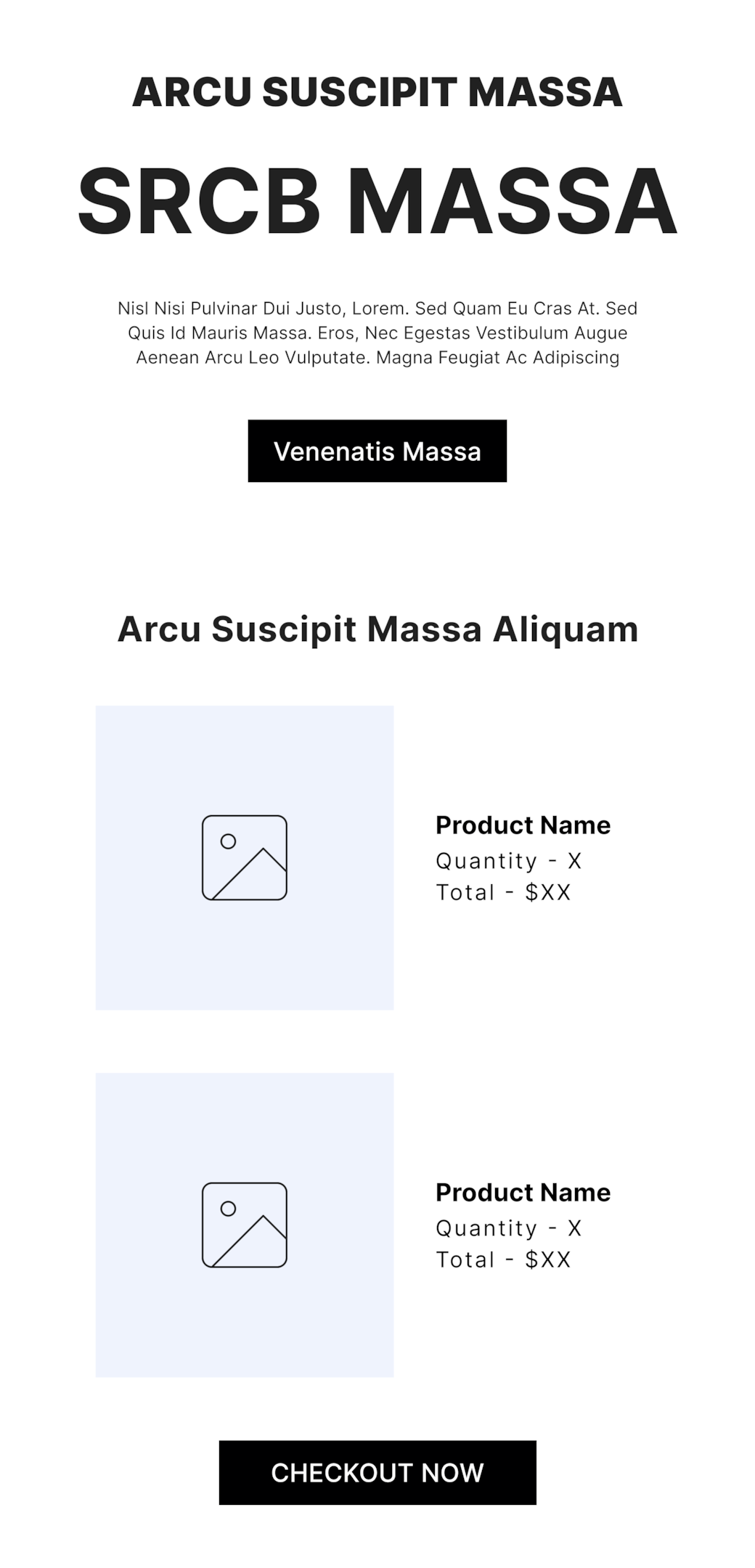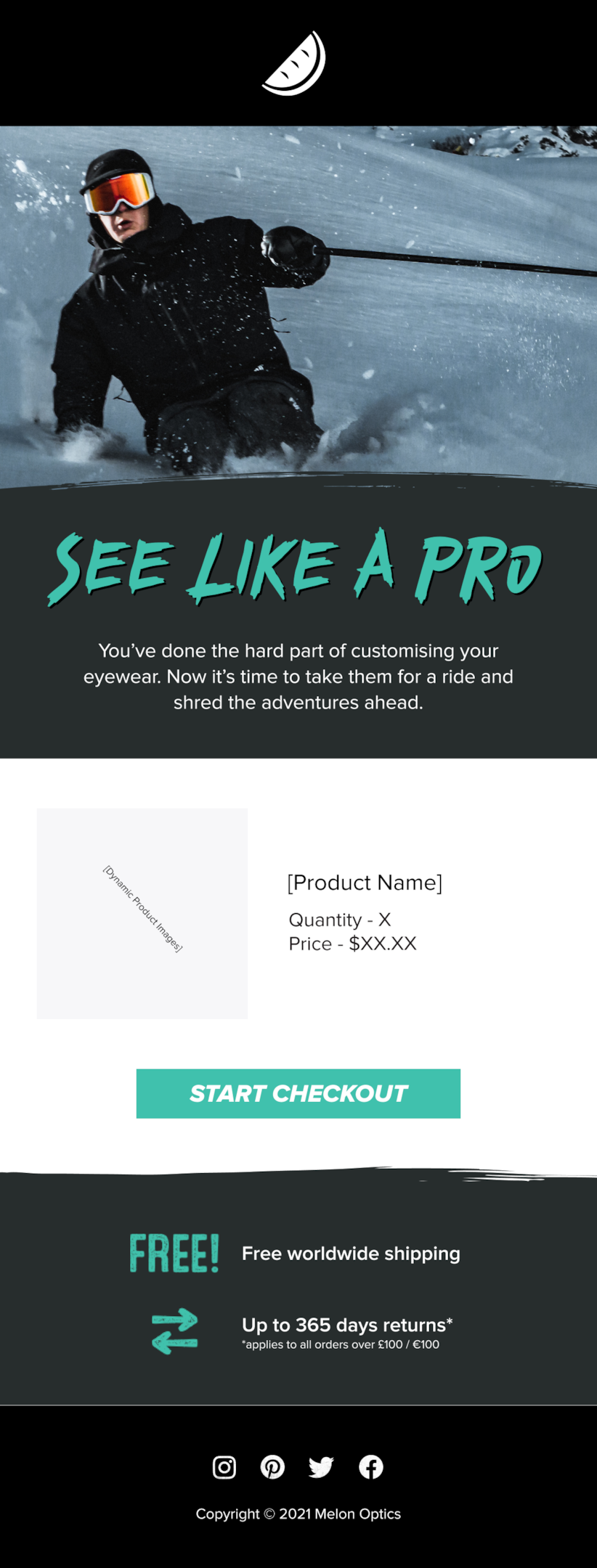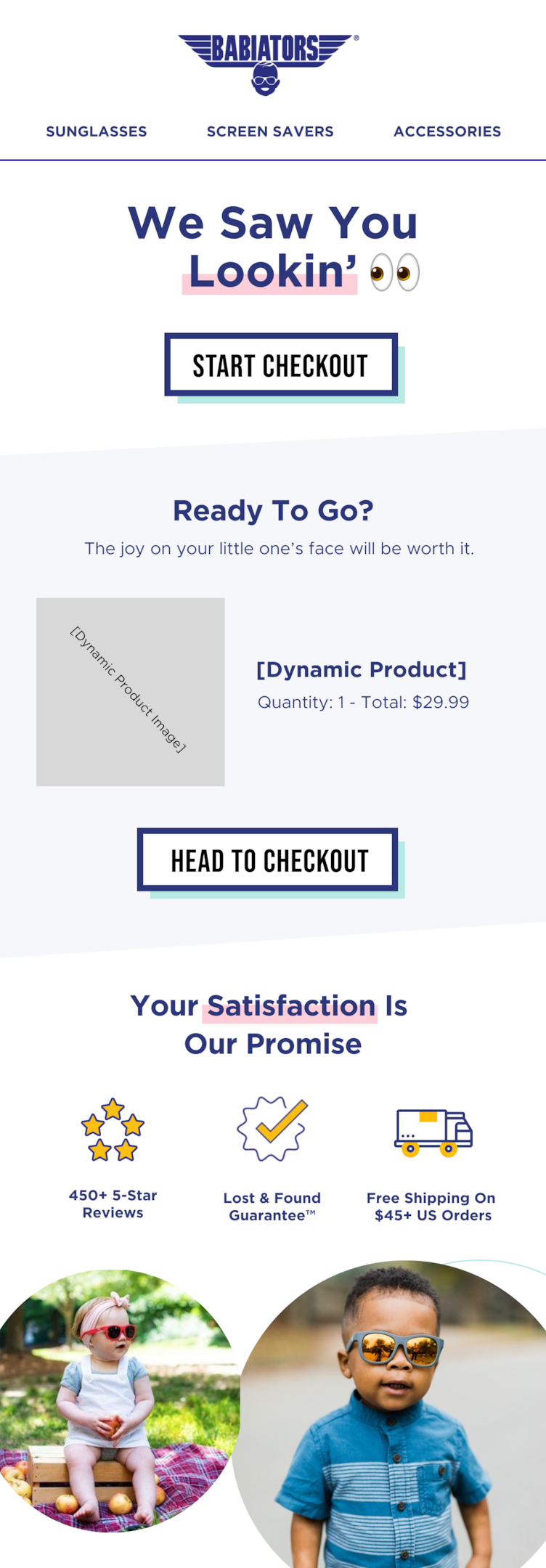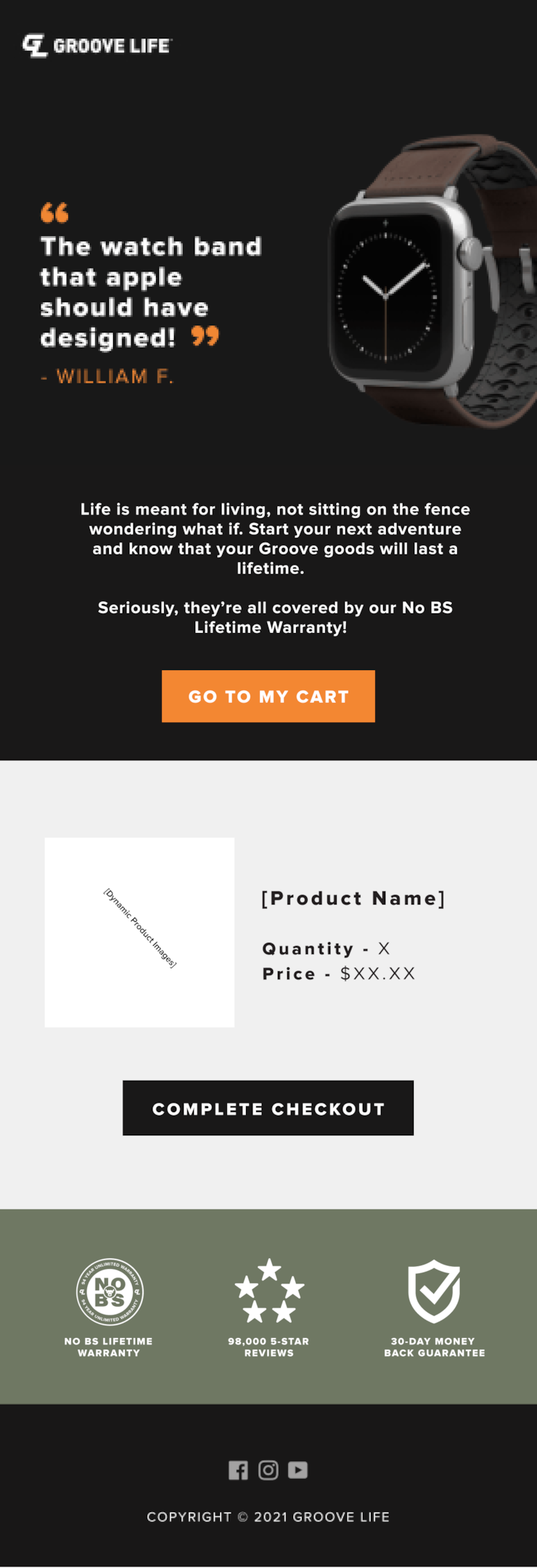Enhancing the Added to Cart Flow with Klaviyo: A Comprehensive Guide
30 Second Summary 1. An Added To Cart flow is different from an Abandoned Cart flow. One targets customers who add products to cart while the other targets shoppers who start checkout. Every e-commerce brand should have both.2. A strong...
Tags
Tools
Level
Related Partners

3. Start by creating an Added To Cart Flow with 2 emails sent over 36 hours
4. Your Add To Cart emails should always have a clear, bold header and a dynamic content block featuring the products they have in their cart.
5. Other elements to have in your add to cart emails are testimonials, product recommendations or content about what makes your brand unique.
The Added To Cart flow is one of the automated email flows that most e-commerce brands don’t set up…and lose out of tens of thousands of dollars in revenue each month. Chances are you’re already familiar with the Abandoned Cart flow, but the Added To Cart flow is different.
Unlike the Abandoned Cart flow that kicks into gear once a shopper initiates the checkout process, the Added To Cart flow sends emails when a shopper adds an item to their cart but doesn’t even start the checkout process.
See the difference? Without an Added To Cart Flow, you’re missing out out on all the shoppers who have showed a clear interest in specific products (by adding them to their cart), but may be hesitant about their choices, uncertain about your brand or simply forgot about their cart.
A strong Klaviyo Added To Cart flow can drive more shoppers to their first purchase & lower your cost per acquisition (CPA). It strengthens your average revenue per lead and per website visitor while also boosting your average order value (AOV).
If you’re launching a new e-commerce store, you should build your Added To Cart flow before launch. So in blog post, we’re giving you the “Zero-To-Launch” approach to launching a high-performing Added To Cart Flow – no fluff, be confident in its performance & one you can optimize later with A/B testing.
Check out our DTC Flow Foundations Guide to learn how to build an Added To Cart to get more interested shoppers to complete their purchase by learning:
- The customer mindset of cart abandoners & strategies to encourage customers to complete their purchase
- The essential components of creating high-converting Add To Cart emails
- How to set up delays, triggers, and filters to target shoppers at the right time
- The A/B tests to optimize your Add To Cart emails
The Added To Cart Flow Klaviyo Setup
Start by setting up the “Added To Cart” event in Klaviyo which will be your flow trigger.

Next, set up the flow & add emails and time delays. A typical Add To Cart Flow should have 2 emails, sent over 24-36 hours.

Crafting the Perfect Added To Cart Emails
When it comes to creating your Add To Cart emails, remember this: you’re reaching out to customers who are already warm—they’ve signalled their intention to buy – you just need to drive them towards completing their purchase.
Start with a strong subject line that gets your email getting opened in a crowded inbox. Make it appealing, make it stand out, but keep it true to your brand. Start with these tried and tested subject lines for added to cart emails & A/B test later:
- “You left these behind!”
- “Your cart is waiting.”
Once a subscriber opens your email, have a strong header that is clear, bold, and drives them to action. Create a sense of urgency—maybe hint at the possibility of stock running out or remind them of a welcome offer discount they haven’t yet claimed. Make sure you also have an eye-catching “Start Checkout” call-to-action (CTA) button) in your header.
Lastly, remind customers of the products they added to cart with a dynamic content block. Klaviyo’s “added to cart” block dynamically shows the customer the product names, images, and prices of the items they’ve added to their cart. And of course, make sure there’s another CTA button directly under this dynamic content block to sandwich the customer’s product selections between two actionable and enticing prompts. This arrangement nudges the customer to click through and start their checkout process.
Added To Cart Series Email Templates
There are a few different types of emails you can send in the rest of your added to cart flow with email wireframe templates from Backbone:
- “Basic Reminder” Template: This simple added to cart email reminds shoppers of the products they added to their cart
- “What Makes Us Different” Template: An added to cart email that emphasizes your unique selling proposition to differentiate your brand and drive conversions
- “Product Recommendations” Template: This add to cart email recommends other products the shopper might like and be more compelled to complete their purchase on
- “Social Proof” Template: This add to cart email leverages customer reviews & testimonials to build trust with your shoppers to convert




Add To Cart Email Examples
There are a few different examples of Klaviyo added to cart emails designed by the Longplay team to inspire you!





And there you have it! If you take away one thing from this blog post, let it be this: simplicity is key. Focus on implementing the best possible version of your Added To Cart Flow before launching your e-commerce brand, or as quickly as possible if you’re already up and running.
The last thing you want is to miss out on potential revenue from interested shoppers. It’s okay to launch your flow and then optimize and A/B test later. Dive in and start building your Added To Cart Flow today!
A white-glove service built for success.
We've planned every part of your client experience so you know you're in good hands.
Related Posts

Discount Offer Flow
The Discount Offer Flow converts more email subscribers into customers by sending them a compelling, limited-time promotion to create a sense of urgency. It drives sales by targeting those who need just a little nudge to take action.What’s A Discount Offer Flow?A Discount Offer flow is a series of emails targeting email subscribers who have been on your list for a while. These subscribers have gone through the Welcome Flow & received campaign emails, but still haven’t converted. This gives them a higher discount to get them to make their first purchase and try your product.# Of Emails: 3Flow Length: 3-7 daysWhat’s the goal of a Discount Offer Flow?To get email subscribers who joined the list 60 days ago to convert into customers.Increasing the non-purchaser conversion rate (ie. % of customers who join the list as non-purchasers to become purchasers)Reducing the time to first conversion (ie. the amount of time it takes someone to go from being aware of the brand to becoming a customer)Increasing the $/lead (this can be from increasing the % of customers who convert or increasing the AOV per customer)Discount Offer Flow EmailsAll emails in the Discount Offer flow are structures similar to a promotion campaign series:Email #1: Offer AnnouncementA promotion...

Mastering the Art of Email Marketing: Best Practices for Success
Email marketing is one of the essential marketing channels that every direct-to-consumer (DTC) e-commerce brands needs to master to grow their revenue, drive conversions, retain customers & build a sustainable, scalable business. With this guide, you'll be able to get from zero to launched & start driving revenue from email marketing. We'll break down the email marketing best practices, from planning your campaigns to analyzing the results.Don't have time to master email marketing yourself?Get started with Backbone to get a custom-built email marketing strategy & email layouts for your business, all based on email marketing best practices.Book Your DemoPlanning Your Email CampaignDefining Your ObjectivesRevenue is always the end goal for any DTC e-commerce brand, but how will this email campaign drive revenue? Before launching your email marketing campaigns, start by defining the objective of the campaign.Here are a few different ways that email campaigns drive revenue:By announcing something new & exciting (such as a promotion, product launch or collaboration)By creating urgency (such as a limited edition product selling out or a promotion ending)By educating customers (such as content emails & seasonal tips)By showing how your product can solve a customer's problems (such as showing how your product works)By showing the benefits of your product...

From Idea To Launch: How To Create A Successful Email Marketing Campaign – 2024 Guide
Email marketing is a powerful tool that can help ecommerce stores nurture, convert & convert potential customers. In fact, email marketing should be generating 20-30% of the total revenue for your ecommerce store.However, creating an effective campaign that converts customers & generates revenue requires more than just adding images & copy to an email template.In this guide, we will walk you through the step-by-step process of building & launching an email marketing campaign from idea to launch. This email workflow will help you build an email marketing strategy for your campaign, write engaging copy, design an email that converts, and send it to the right audience.You'll also learn actionable tips to help you create campaigns that drive engagement and revenue for your business. Whether you're new to email marketing or a seasoned pro, this guide will give you the tools and knowledge you need to create successful campaigns that drive results.Step 1 // Email Brief: Building Your StrategyThe first step in creating a successful email marketing campaign is to develop an email brief. This is typically done by the Email Marketing Manager or the Head of Marketing. An email brief is a document that outlines the key information for your...

Building An Email Marketing Team: The 6 Roles Of A Dream Team
Often ecommerce stores grow from 6-figure to 7-figure & 8-figure companies before they wish they had invested more into email earlier on. Often this means ecommerce stores are easily leaving hundreds of thousands of dollars on the table.Email marketing is a powerful tool for any business, and it's essential to have the right team in place to maximize its potential.But what does an effective email marketing team look like?From the strategic planner to the creative designer, each role plays a vital part in building a team that can strategize, create and execute effective email campaigns that drive engagement and revenue.By understanding these roles and how they work together, you'll be able to build a team that can take your email marketing efforts to the next level.Here we'll explore the 6 key roles that make up a dream email marketing team, and how each role contributes to the success of your email marketing efforts:1. The Email Marketing ManagerA successful Email Marketing Manager also known as an Email Strategist, is able to develop and implement a comprehensive email marketing strategy that aligns with the overall business goals, and consistently delivers results in terms of email engagement, conversions and revenue.They lead and manage...

The 6 Most Important Email Marketing Metrics You Should Be Measuring For Your Ecommerce Store
Email marketing is an essential aspect of any e-commerce business, and it's important to have the right metrics in place to measure the success of your email marketing efforts.One of the most important (and often overlooked) steps in executing a successful email marketing strategy is analyzing how your customers respond to your emails and applying what you learn along the way.But most companies only track open and click rates or the total revenue coming from their emails. The problem is, this doesn’t paint the full picture of how their email marketing is directly affecting their bottom line nor provide actionable insights to improve email performanceHere are the most 6 important email marketing metrics that e-commerce brands should be measuring to ensure that their campaigns are effective and driving revenue:1. Percentage of RevenueLet’s say you’re making $10,000 from email every month. That sounds pretty great right?Maybe.It is, if your ecommerce store is generating $30,000 in revenue per month. But it's a sign of underperformance if your ecommerce store is generating $150,000 in revenue per month.Most ecommerce stores make the mistake of only tracking total email marketing revenue.Instead, monitor how big a slice of your revenue pie is coming from email marketing and adjust...

How To Setup Klaviyo In 15 Minutes – 2024 Complete Guide
What is Klaviyo?Klaviyo is an all-in-one email marketing automation platform that allows e-commerce businesses to create and send highly targeted email campaigns, track customer behavior, and analyze the performance of your campaigns.With Klaviyo, you'll be able to generate more sales, increase customer engagement, and build sustainable growth. It seamlessly integrates with your e-commerce store, making it super easy to automate & personalize those important follow-up emails, like abandoned cart reminders and personalized product recommendations.Using a marketing automation platform like Klaviyo is absolutely critical for all ecommerce brands in 2024.Is Klaviyo the best email marketing automation platform for my ecommerce brand?If you're a DTC ecommerce store owner, you know that choosing the right email marketing platform is crucial for your business success.While there are several options available, such as MailChimp, Active Campaign and others, Klaviyo stands out as the best choice for e-commerce stores for a few reasons:Automation: Klaviyo's automation capabilities are specifically designed for e-commerce businesses, making it easier to set up and execute targeted campaigns, such as abandoned cart reminders or personalized product recommendations, which can increase conversions and boost sales.Segmentation: Klaviyo's segmentation features are more advanced compared to its competitors, allowing you to create highly targeted campaigns and send messages...

How To Use Klaviyo Like A Pro – 2024 Complete Guide
1. Create an emailBuilding an email in Klaviyo is extremely simple with their drag and drop builder. You can also follow the same steps below to create an email for a flow since their email builder is the same for both types of emails.To get started with creating an email in Klaviyo, click on "Email Templates" then click "Create Template". This will bring you to their email builder. This is a good way to get familiar with building an email in Klaviyo before learning to set up flows and send campaigns.Here are the key elements to create emails that engages subscribers and converts customers:Subject Line: The subject line is the main text an email subscriber sees in their inbox before they open the email. You want your subject lines to generate curiosity & interest for the reader to read the email.Preview Text: The preview text is the additional information after the subject line that gives the reader more context on what the email is about within their inbox.Navigation Bar: The navigation bar is typically in every email and directs the reader to key pages on your website.Banner: A banner in an email is typically a short section above the header of the email to...

Welcome Flow
The Welcome Flow is a series of emails to greet new email subscribers. It builds trust & generates revenue by sharing your brand story, introducing them to your products & encouraging them to make their first purchaseWhat’s A Welcome Flow?A Welcome Flow is the first point of contact between your brand and a new email subscriber subscriber. Once a website visitor opts-in to your email list through your website pop-up, the Welcome Flow introduces the lead to your brand & products.# Of Emails: 5Flow Length: 5-10 daysWhat’s the goal of a Welcome Flow?To get non-purchasers to make their first purchase by introducing them to the brand & guiding them towards the product(s) they should purchase which:Converts more new email subscribers into paying customers (which means more revenue!)Gets potential customers to make their first purchase faster (ie. the amount of time it takes someone to go from being aware of the brand to becoming a customer)Gets more revenue out of each lead you drive to your website (which means lower CPAs & more value from your website traffic)Generates a higher average order value (AOV) for first-time customers by introducing them to more products that they may be interested inWelcome Flow EmailsEmail #1: WelcomeAn email to welcome...

Post-Purchase Nurture Flow
The Post-Purchase Nurture Flow maintains engagement by thanking customers, educating customers on how to use the product & sharing content relevant to their challenges. It targets recent buyers, fostering a post-purchase relationship that enhances customer loyalty and lays the groundwork for repeat business.What’s A Post-Purchase Nurture Flow?A Post-Purchase Nurture Flow is the first few emails a customer gets after they make a purchase (besides transactional emails like an Order Confirmation). This is one of the most commonly underused but important emails for a DTC ecommerce brand because it builds brand loyalty with purchasers.The best way to keep customers is to make sure they have a great experience of your brand and products, so they return to make future purchases.That’s why building a great Post-Purchase Nurture flow is the first step to retaining more customers, getting more repeat purchases & increasing customer lifetime value (LTV). An effective Post-Purchase Nurture builds brand loyalty by thanking customers, educating them on how to get the most of your products.# Of Emails: 5Flow Length: 10-15 daysWhat’s the goal of a Post-Purchase Nurture Flow?To nurture customers to become repeat customers & raving fans which:Increases your repeat purchase rate by getting more customers to return to make additional purchasesGets...

The Guide to Email Marketing KPIs: How to Measure and Optimize Your Email Campaigns
Like most marketing channels, growing your email revenue is a process of continual growth and optimization. Once you're regularly sending out email campaigns, your email marketing KPIs will tell you where there is room to optimize, try new campaign ideas, and run A/B tests. E-commerce brands often leave thousands of dollars of revenue on the table because they don't regularly review their performance & optimize their email marketing strategy based on their insights. Sometimes, something as simple as a different send time or a change in the email layout can create 15-20% more lift in revenue. Sometimes, your email marketing KPIs will help you identify new types of email marketing campaigns that your subscribers engage with more.Another common mistake e-commerce brands make is sending out the same few email marketing campaigns each month, which eventually end up feeling repetitive to subscribers. Regularly measuring & optimizing your campaigns includes coming up with new ideas to test.To make the most out of your email marketing efforts, every e-commerce brand should follow this process:Send Email CampaignsUpdate A Weekly Reporting DashboardAnalyze the data at least once a month (ideally weekly!)Identify opportunities for A/B tests, segmentation, and other campaign ideasDeploy new tests & ideas on...


